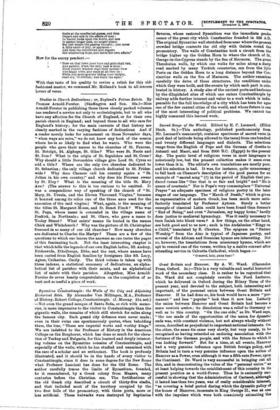Studies in Church Dedications ; or, England's Patron Saints. By
Prances Arnold-Forster. (Skeffington and Son. 36s.)—Miss A.rnold-Forster in publishing these three closely packed volumes has rendered a service not only to ecelesiologists, but to all who have any affection for the Church of England, or for their own parish church in England ; and beyond these to all who care for England's history; for the main currents of that history are clearly marked in the varying fashions of dedications,. And if a reader merely looks for amusement on these November days, "when ways are mire," we do not know any book of the season where he•is so likely to find what he wants. Who were the people who gave their names to the churches of St. Pancras, St. Botolph, St. Alphege, St. Giles ? Who were St. Neots and St. Ives? What is the origin of St. Sepulchre and St. Cross ? Why should a little Devonshire village give Lord St. Cyres so odd a title ? Where are the only two churches dedicated to St. Sebastian ; the only village church dedicated to St. Prides- wide ? Why does Chaucer call his country squire a "St. Julian in his own country," and why does his Prioress swear by St. Eloy ? What is the meaning of the title St. Mary Are? (The answer to this is too curious to be omitted. It was a compendious way of speaking of the church of " St. Mary, St. Ursula, and the Eleven Thousand Virgins," because it boasted among its relics one of the three axes used for the execution of the said virgins.) What, again, is the meaning of the titles St. Margaret Moses, and St. Benet Finck ? Who was St. Pega, whose name is concealed in the village name of Peakirk, in Northants ; and St. Olave, who gave a name to Tooley Street ? What saints' names lie buried in the names Chick and Whitchurch ? Why was the picture of St. Christopher frescoed in so many of our old churches ? How many churches are dedicated to Charles the Martyr ? These are a few of the questions to which one learns the answers as one turns the pages of this fascinating book. Not the least interesting chapter is that which tells the legends of our own English ladies, SS. Audrey, Frideswide, Ethelburga, Ebbe, and the rest, whose names have been ousted from English families by foreigners like SS. Lucy, Agnes, Catherine, Coolly. The third volume is taken up with three indexes, a statistical summary of dedications, an alpha- betical list of parishes with their saints, and an alphabetical list of saints with their parishes. Altogether, Miss Arnold- Forster de-erves hearty congratulation on the completion of so vast and so useful a piece of work.






















































 Previous page
Previous page